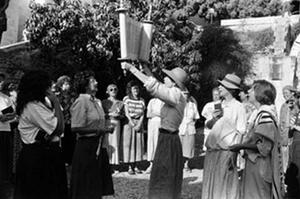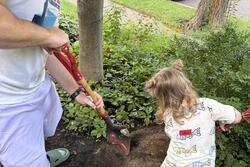Women of the Wall: Keeping the faith for 21 years
Courtesy of Joan Roth.
You may have heard about the arrest last month of medical student Nofrat Frenkel for wearing a tallit (prayer shawl) when she prayed with Women of the Wall (WOW), a monthly women's prayer group that meets at the Western Wall in Jerusalem. What is perhaps more surprising than the fact that a woman can be arrested in Jerusalem simply for praying in a way that does not conform to Orthodox preferences (and I say preferences because a woman wearing a tallit is not explicitly prohibited by Jewish law), is that WOW has been fighting this fight for 21 years. Twenty-one years of facing hurled chairs as well as insults, court fights, and compromises, of steady, tireless perseverance and continued joy in the act of praying with a community of women.
What became Women of the Wall was born on December 1, 1988. A multi-denominational group of about 70 women -- in Israel for the first International Jewish Women's Conference -- held a women's prayer service at the Wall, bringing a Torah scroll with them to the women's section of the plaza. Their service began uneventfully, but when they opened the Torah, a woman onlooker began to yell, attracting the attention of some men on the other side of the mechitzah (partition between the men's and women's sections), who joined in the harassment. Rather than chasing away the women, this experience reinforced their desire to hold their own service, their way, at the Wall. A group of Israeli women decided to continue the tradition, meeting monthly on the first day of the new moon, for a service in the same model.
That model challenges some of the restrictions on women's activities at the Western Wall. According to Israeli law, women have access to the Wall (on the women's side) but are not allowed to pray out loud, to sing prayers, to wear tallitot (prayer shawls), to wear tefillin (phylacteries), to blow a shofar, or to carry or chant from a Torah scroll. But the WOW model is also restrained, only seeking to legalize activities that are permitted by halakhah (Jewish law). It doesn't challenge the mechitzah (barrier separating men and women). The services do not include the prayers for which a minyan (prayer quorum, traditionally ten men) is required, to enable the participation of Orthodox women who do not believe a group of women can constitute a minyan.
Despite these compromises, WOW has faced regular violence. Ultra-Orthodox protestors have thrown chairs at the women, attacking them physically and verbally, ripping prayer books from their hands, injuring some. In the summer of 1989, the Israeli WOW group asked the Supreme Court for protection. The court accepted the case but asked the group to stop its activities while the case was being considered. WOW then changed its model to hold the first part of its prayer group at the Wall but hold the Torah service nearby. After delays and Knesset commissions to study the situation, the Court decided that WOW has the legal right to pray in their own way, and gave the government six months to figure out a way to manage WOW "while taking into consideration the sensitivities of the other worshippers at this site." (This deadline was not met.)
Rather than punish those who carry out violence against WOW, the Israeli government has instead punished the group for ostensibly provoking the violence, banishing (and in the case of Frankel, arresting) the peaceful women instead of the violent mobs. In a compromise agreement, WOW holds the first part of the service at the Wall, and then moves to Robinson's Arch, a nearby but entirely separate archeological site, to read from the Torah.
Personally, I don't find the Western Wall to be particularly spiritual or moving. The intense holiness ascribed to this outer retaining wall of the Second Temple feels to me like fetishizing, and the Ultra-Orthodox control over the space alienates me. But I've joined Women of the Wall for prayer several times because their cause is more important than simply the right to pray at this particular site -- it's a movement for religious pluralism and human rights in Israel, challenging the right of the Ultra-Orthodox leadership to determine the structures and boundaries of religious expression. As such, WOW deserves recognition as more than a monthly prayer group. It's a historical force, working for change through legislative channels, personal modeling, and spiritual activism. And it's needed more than ever, as the Ultra-orthodox forces in Israel become increasingly outrageous in their attempt to control public space, expanding gender segregation on public buses that serve religious neighborhoods, on sidewalks in religious areas, and most recently planning to make Jerusalem psychiatric hospitals single-gender.
So on this Day of Solidarity and Support, I call for women who have participated in WOW over the past 21 years to help build its historical record. There is no official archive of WOW (yet), and while the excellent anthology on WOW contains a detailed timeline, it does not include a list of the 70 who took part in that first service 21 years ago. As far as I can reconstruct, the women listed below were among those original 70. Please share additional names -- and any stories you may have -- in the comment section, and add your photos to the Flickr collection documenting Women of the Wall. Together, we can help build on the strength of 21 years of committed activism, integrating women's stories into the historical record of the fight for religious pluralism.
Some of the original 70 participants in WOW: Rivka Haut; Phyllis Chesler; Bonna Haberman; Anat Hoffman; Karen Erlichman; Rabbi Helene Ferris; Beryl Michaels; Rabbi Deborah Brin; Francine Klagsbrun; Norma Baumel Joseph; Geela Rayzel Raphael.









That first women's prayer service at the Kotel in 1988 was a life-changing experience for me. Now, over 20 yrs later, we have a painful reminder that our voices and our activism are still greatly needed. People of all genders have the right to pray with the fullest, most authentic expression of their Divine selves. So I will proudly daven with my community next month in support of Nofrat Frankel, and in support of any and every person who has experienced this kind of oppression in their Jewish communities.